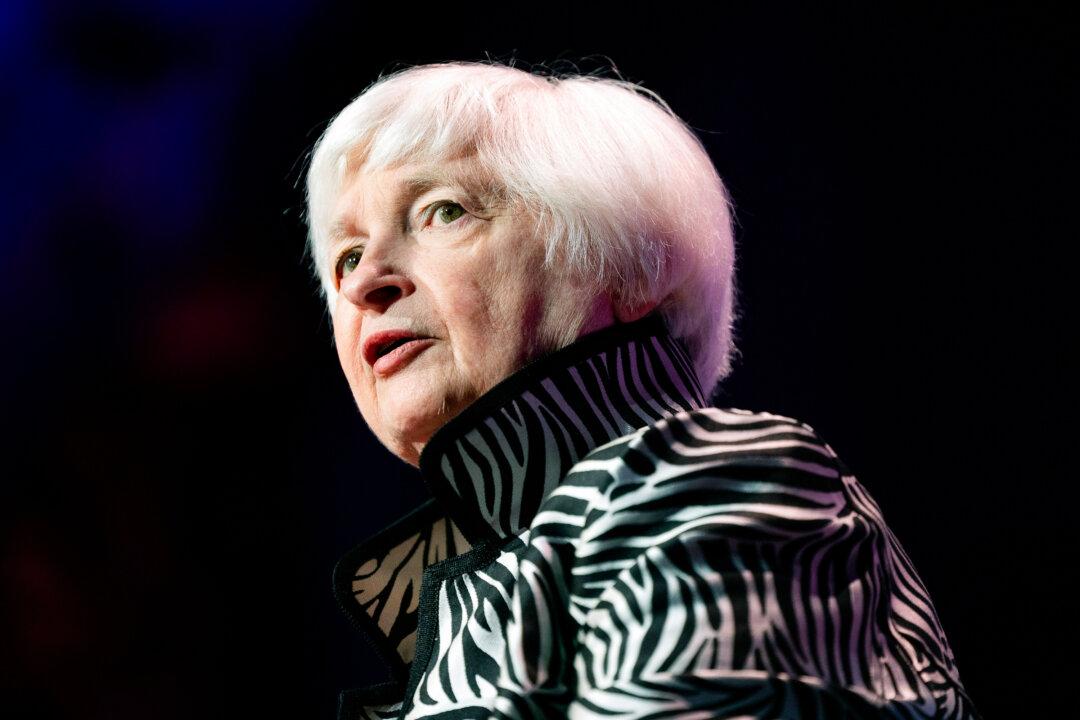There’s a scene in a Fred Astaire and Ginger Rogers film in which the boss of a law firm leaves for vacation and puts his intellectually limited Cousin Egbert in charge. The note reads, “Don’t do anything.”
This is exactly the note that the Federal Reserve needs now. Just stop doing things.
Its record-breaking rate increases over the past year—not in height but speed and degree of increases—have massively disrupted bank balance sheets, shifted capital investment structures, and added huge costs to financing at a time of high inflation.
They were made necessary by the wild printing spree of the two previous years, which enabled the biggest expansion of government in our lifetimes and unleashed domestic dollar devaluation, thus pillaging the poor and middle classes.
Those actions, in turn, they claim were necessary to fix the COVID-19 pandemic. That’s why the Fed had to pause its prior tightening campaign from 2019, which was made necessary by full 11 years of zero-interest-rate policy, which caused the over-financialization of the whole economy and caused a preposterous bubble in media and tech over retail and basic savings.
Indeed, a whole generation has forgotten that one is supposed to save money and also that doing so is supposed to be financially rewarding.
The rotten 2008 policy was a result of its previous reckless policies that caused the housing boom. To be sure, the Fed had collaborators with government-backed mortgage companies that proved a ready market for repackaged and collateralized mortgages that buried the chaff with the wheat until the whole thing blew up.
We could continue this march of folly all the way back to its founding in 1913. The Fed was created to end the problem of business cycles and wildcat banking. It was supposed to bring science and rationality to money and banking. Its first action was to provide backstop funding for the United States to enter the Great War with conscription and mass death.
The promise of scientific monetary policy has eluded this institution for 110 years. The sound dollar in 1913 is now worth 3 cents. This history is a terrible indictment of the whole institution.
![(Data: Federal Reserve Economic Data [FRED], St. Louis Fed; Chart: Jeffrey A. Tucker)](/_next/image?url=https%3A%2F%2Fimg.theepochtimes.com%2Fassets%2Fuploads%2F2023%2F05%2F04%2Fid5242396-1-JAT-2023.04.05-1200x910.png&w=1200&q=75)
In any case, here we’re finally at what Fed chief Jerome Powell calls the terminal rate: 5.25 percent. He means the rate at which short-term interest rates equal the inflation rate, which is still sticky on the consumer side but falling on the production side. One supposes that truly positive rates will be here by the summer. Unless something changes.
Just how high are rates now? Sorry to point this out, but in real terms, the federal funds rate is now zero. Measured against the sticky-price index minus food and energy, we aren’t even at zero yet. It’s not yet clear that you can actually make money from saving money once you consider inflation. Thus has a basic promise of capitalism been betrayed by the Fed.
Is it really any wonder that our culture no longer favors thrift, deferred consumption, investment, and saving for a rainy day? Is it any wonder that young people are completely clueless about personal finance and instead choose to live it up on credit cards? This is what the Fed has done.
Rates simply aren’t high. They’re still far too low. We haven’t been in the realm of financial rationality for nearly a quarter of a century. The last time we had economic clarity was in the 20th century before the world went nuts with the turn of the millennium.
![(Data: Federal Reserve Economic Data [FRED], St. Louis Fed; Chart: Jeffrey A. Tucker)](/_next/image?url=https%3A%2F%2Fimg.theepochtimes.com%2Fassets%2Fuploads%2F2023%2F05%2F04%2Fid5242398-2-JAT-2023.04.05-1200x923.png&w=1200&q=75)
“There have been three so-called tightening cycles since 2001. Inflation-adjusted rates were barely positive during February 2005 to 2008, microscopically positive during 2019 and not even there yet this time around the barn. More importantly, when you look at the entire picture since October 2001, after rates were first pressed to near the zero-bound by Alan Greenspan in a desperate move to cure the dotcom crash, the monetary verdict is stunning. To wit, during 83 percent of the 257 months since then, the Fed’s policy rate has been negative in real terms.
“Needless to say, during the vast expanse of 221 months when real rates were negative or just a smidgen above the zero-bound the central bank was essentially serving up a Devil’s Workshop for speculation, error, mischief and malinvestment throughout the length and breadth of the entire US economy. That’s because there should never be negative real rates. Period.
“So is it any surprise that both the financial system and the main street economy are riddled with bubbles and accidents waiting to happen? Similarly, how could there be any surprise that the small banking sector is in trouble when it was essentially the Fed’s policy to swamp banks with dirt-cheap deposits and then induce them to recklessly search for yield? As it happened, that’s how the likes of First Republic Bank, Silicon Valley Bank and Signature Bank, among numerous others, experienced a temporary ballooning of net interest margins, profits and stock prices.”
Powell is now strongly hinting that the Fed’s campaign of higher rates is at an end. He cited the strong labor market, which everyone with an ounce of sense knows is completely illusory. It’s hard to know if he’s ignorant or just lying for the camera.
There’s no way to know for sure if more rate increases are on the way. The pause is more likely driven by fear of the instability in the banking sector with massive failures and Federal Deposit Insurance Corp.-financed acquisitions to cover up for what are really tax-funded bailouts.
How much more of this can the system endure? It’s possible that the Fed really is throwing in the towel, even though inflation isn’t near its target and the structural imbalances in the production sector are nowhere near fixed.
As for the Fed’s balance sheet, it’s still a huge mess. There’s a long way to go before that approaches normalcy. And yet, with rates finally out of the ditch, the Fed does have more room to maneuver. That’s good news for them but not us. The Fed will be under enormous pressure in the coming months and years to once again step up to dig the economy out of recession, which will mean yet another repeat of these endless cycles.
Meanwhile, even now, with the Fed’s latest rate increase, the pillaging and punishing of the thrifty is still the rule of the day.
Someone needs to be in a position to stop this madness. A gold standard would be glorious. Even just a hard rule on what precisely the Fed is trying to do. The best of all worlds would be an end to the Fed itself. Let banks operate like real businesses instead of socializing the costs of bailouts while privatizing the gains. The financial oligarchs have been in charge for far too long.
The best instruction for the Fed right now is simple: Don’t do anything. Stop with the manipulations and attempts to outsmart market forces. A recession is coming, and it should be allowed to take its own course with no attempts to save any bank or financial institution. We need the pain of economic reality as a precursor to getting back to a growing economy.







